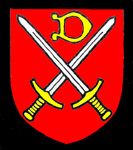The Manor of Caddington

Saint Paul's Dean and Chapter
By the time of the Domesday Book of 1086 all Caddington was held by the Dean and Chapter of Saint Paul’s, London. A history of the manor was given in The Victoria County History for Bedfordshire, Volume II, published in 1908. What later came to be called Caddington Manor was in Hertfordshire [see below] until 1897.
The writer suggested that the manor could be traced back to a grant of King Offa of Mercia (757-796) granting it to Saint Albans Abbey “but apparently no records exist of its subsequent history until the time of Edward the Confessor”. It was not unknown for such awards of land by Anglo-Saxon kings to religious houses to be medieval forgeries by the houses themselves in order to claim land. The dean and chapter continued to hold the manor until 1649 [CRT130/Caddington4/2] when it was sold to Henry Proby and John Hammond, both of London, drapers. When King Charles II (1660-1685) was restored to the throne the manor was returned to Saint Paul’s who continued to hold it until 1872 when the Ecclesiastical Commissioners for the Church of England took it over. A succession of Law of Property Acts in the 1920s extinguished all manorial incidents, courts and copyhold tenure of land. This effectively abolished manors in all but name. The manor house was probably on the site of today’s Bury Farm.
Manor court rolls are preserved, though they are not held at Bedfordshire and Luton Archives and Records Service, but a transcription from the 16th to the 18th century has been made and is available [CRT130/Caddington1]. The Victoria County History states that the manor was leased out by the dean and chapter – to churchmen in the 12th and 13th centuries but to laymen by the reign of Edward IV (1461-1483).
The first volume printed by Bedfordshire Historical Record Society, in 1913, has an article by C. Gore Chambers on the lease of Caddington Manor. He describes the manor as follows: “There were thirty prebendaries of Saint Paul’s. Each of these had assigned to him a manor, as his prebend or provision, and of that, as long as he remained a prebendary, he became the freeholder … But the dean and some twelve or fifteen of the canons and prebendaries were residentiaries and performed duties in connection with the cathedral. These, and the establishment which served them, were supported by an income derived from those of the chapter manors which had been reserved and were not assigned to individual prebendaries. The lessees of such manors were generally some of the canons themselves and the rent was paid partly in money and partly in produce … In Domesday Books Caddington is said to be a ten-hide manor belonging to Saint Paul’s. But the hide, as there used, can only be regarded as a unit of assessment, and gives little help to calculation of area, the actual amount of land amounting to about 2,400 acres. Out of this estate the chapter carved three manors; two of them known as Caddington Major and Caddington Minor, both of them in Bedfordshire, were assigned to two prebendaries. The third, known as Caddington Manor, was in Hertfordshire, but is now in Bedfordshire; it was one of the manors reserved for the support of the cathedral establishment”.